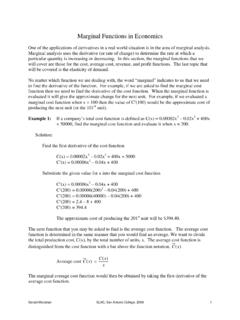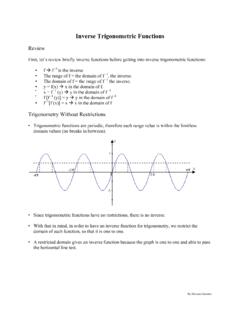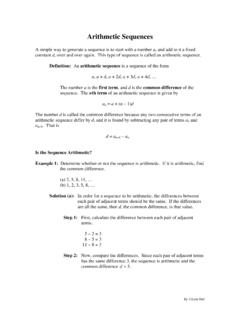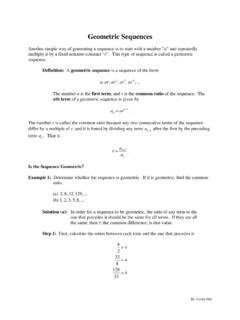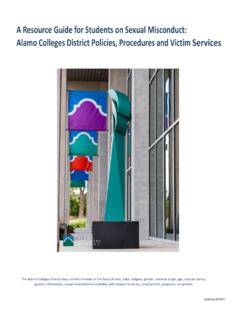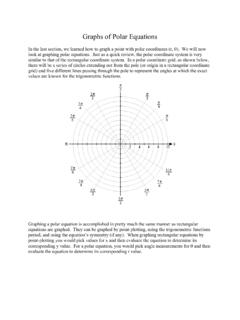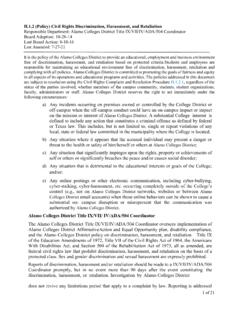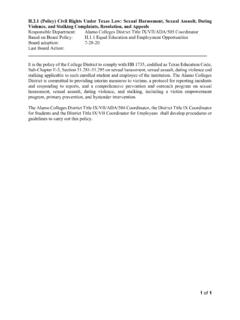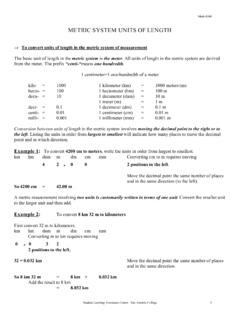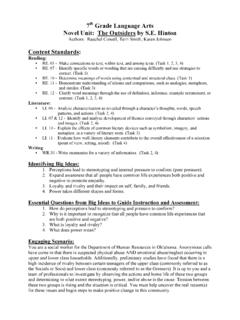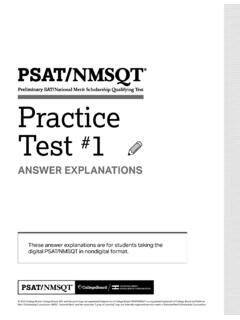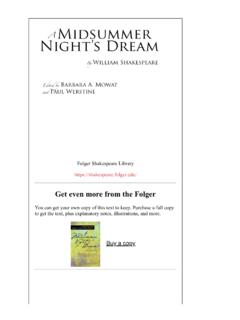Transcription of Elements of a Literary Analysis - Alamo Colleges District
1 This handout was created using and San Antonio college Writing Center | Gonzales Hall 203 | 210-486-1433 July 2020 Elements of a Literary Analysis In order to know what to look for in a text before you write your Literary Analysis essay, you need to know your Literary terms. Knowing your terms will be beneficial to you, so you can consider what you want to discuss in your essay. Below are Literary Elements to choose from when writing your Literary Analysis . Literary Elements : Theme The message/es explored throughout a work of literature.
2 Motifs -- Repeated patterns in the story, particularly the symbolic. Plot The arrangement of events; consider chronol-ogy or use of flashback/flashforward. Setting The time and place (or when and where) of the story. It can be time period, location, the time of day, the season, the weather, the type of room or building. Three types of setting to keep in mind are Physical, Historical, and Atmospheric. character is a person, animal, being, creature in a story. Writers use characters to perform the ac-tions and speak dialogue, moving the story along a plot line.
3 Examples: Protagonist, Antagonist Characterization - is a writer s process used to de-velop their characters throughout the story. The au-thor uses details to teach us about a character . This is used over the course of a story in order to tell the tale. There are two types of characterization, Direct and Indirect. Point of view The vantage point from which the story is told. Who is telling the story? There are three points of view a story can be told from, First-person, Second-person, and Third-person. Diction Refers to word choice and phrasing in any written or spoken text.
4 There are two types of diction: Formal and Informal. Denotation- Dictionary definition of a word. Some-times a word can have multiple definitions. Consider the way the word is used in context to the story. Connotation - Feelings and images associated with a word or phrase. Tone is the author s attitude towards the subject they are writing about. Mood- is the atmosphere of the story. The reader de-termines the feel of the story. Types of Elements Certain Elements have extensions within them. Here are a list of those types of Elements .
5 TYPES OF PLOT: Exposition The opening of the story that sets up the characters, setting, (time and place), and basic information in introduced. Conflict The protagonist struggles between oppos-ing forces. It can be external: person vs. person, per-son vs. person vs. nature, person vs. society, person vs. technology, person vs. supernatural. It can be in-ternal: person vs. self. Rising Action The main character faces a series of conflicts. Crisis A significant turning point in the story that determines how it must end.
6 Climax The highest point of tension or drama in a narratives plot. Often climax is also when the main problem of the story is faced and solved by the main character or protagonist. Falling Action The story begins to slow down and work towards its end, tying up loose ends. Resolution/Denouement The conclusion of the story s plot. TYPES OF SETTING: Physical - The place where the story occurs. Ex. The setting of Trifles takes place in a farmhouse. Historical - The time period in history that either sur-rounds the story.
7 Ex: The Yellow Wallpaper takes place around the nineteenth century, which is im-portant to why the protagonist is treated a certain way by her husband. This handout was created using and San Antonio college Writing Center | Gonzales Hall 203 | 210-486-1433 July 2020 Atmospheric - The feeling, emotion, or mood that an author creates in a narrative through descriptive lan-guage. TYPES OF character : Protagonist This is the main character , around which the whole story revolves. Antagonist This character , or group of char-acters, causes the conflict for the protagonist.
8 The antagonist could be the protagonist, who is torn by a problem within. Foil Opposite character traits from another, char-acter meant to help highlight or bring out another s positive or negative side. Static Do not change throughout the story. A ma-jor character can remain static through the whole story. Dynamic Changes throughout the story. They may learn a lesson, become bad, or change in complex ways. Flat Has one or two traits, usually only all positive or negative. They are the opposite of a round char-acter.
9 The flaw or strength has its use in the story. Round Opposite of the flat character . Characters have many different traits, good and bad, making them more interesting. TYPES OF CHARACTERIZATION: Direct: The author explicitly tells the audience what he or she wants you to know about the character . Indirect: The reader makes inferences about a char-acter based on their actions, thoughts, personality, and emotional affect on other characters. There are five types of Indirect characterization: Speech, Thoughts, Effect on others, Actions, and Looks.
10 TYPES OF POINT OF VIEW: First-person: The story is told through the eyes of the character telling the story. Second-person: The narrator is speaking to you. This is seen mostly in poems, speeches, instructional writing, and persuasive articles. Third-person: The narrator is describing what s seen, but as a spectator. If the narrator is a character in the story, then we are reading what he or she ob-serves as the story unfolds. The story can be told from an omniscient (all-knowing) narrator who doesn t interact in the events, or a limited omniscient character who knows only one other person s thoughts or feelings, or character who has a limited perspective of the events unfolding.

